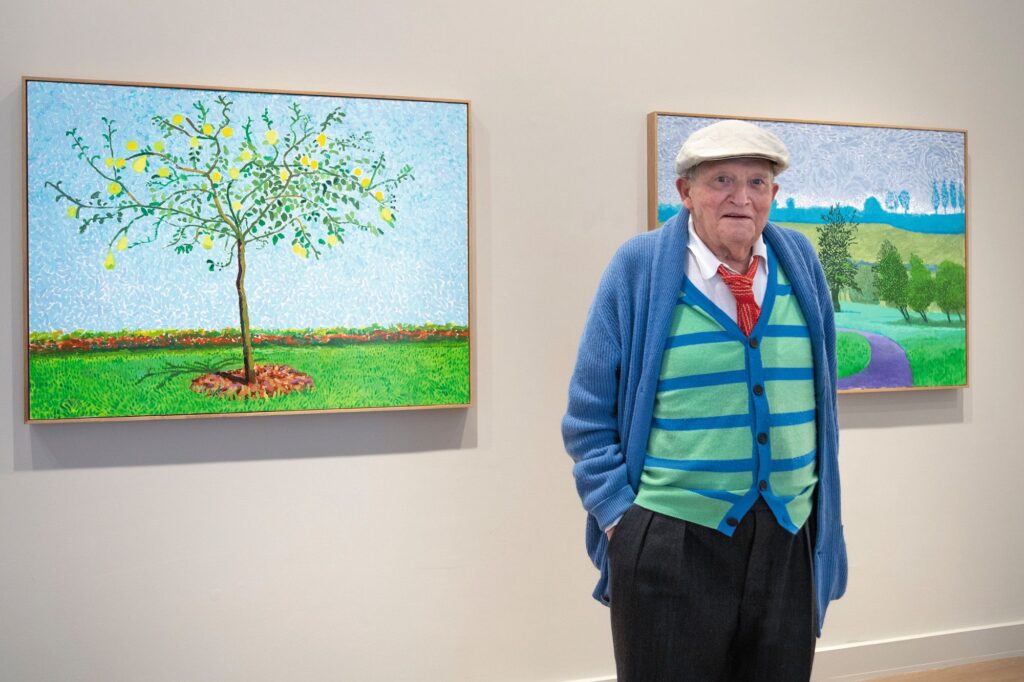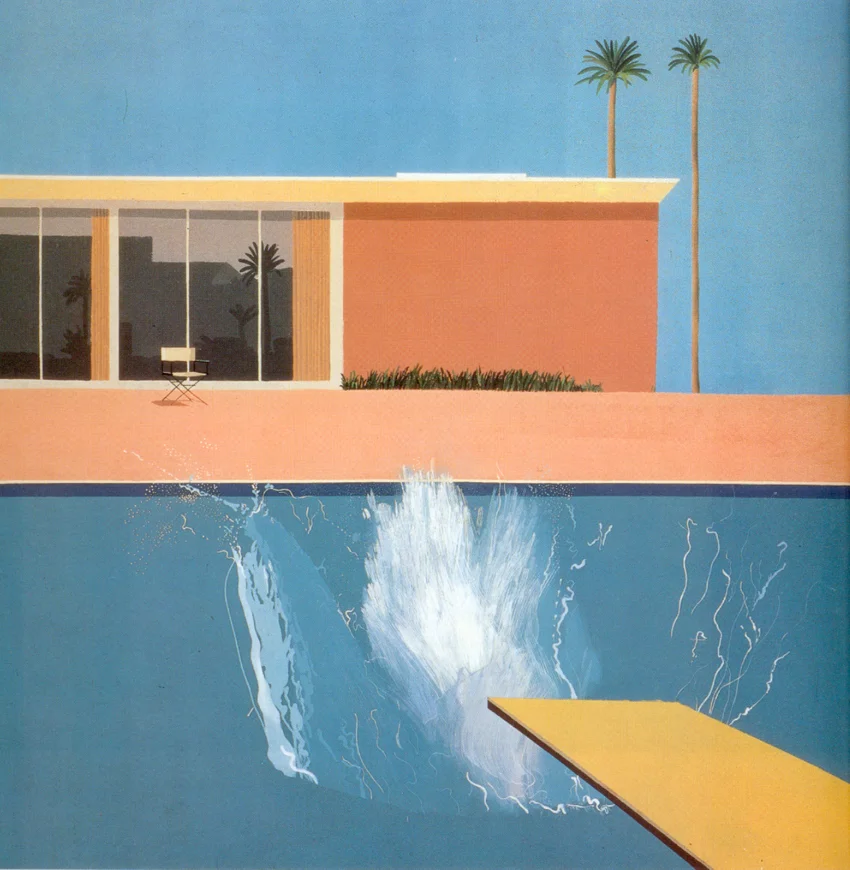Hi there! Let’s dive into the realm of contemporary art, few pieces stand as prominently as David Hockney’s “A Bigger Splash.” This exploration aims to dissect the intricacies of this seminal artwork, delving into the artist’s background, the cultural context of its creation, and the enduring impact it has left on the art world.
Who was David Hockney?

Born in England in 1937, David Hockney emerged as a transformative figure in the art world. His artistic journey began with formal studies in art, propelling him into the limelight with depictions of Los Angeles’ pool culture, a symbol of 1960s hedonism.
FUN FACT: Hockney’s iPad drawings gained widespread attention and acclaim, demonstrating his adaptability and innovation even in his later years. This embrace of digital technology showcases Hockney’s continual exploration of new mediums and his ability to push the boundaries of artistic expression.
His Career
Over a career spanning more than 60 years, Hockney not only defined a generation but continually pushed artistic boundaries. His repertoire extends across photography, set design, landscape painting, and even iPad drawings, earning him accolades and international exhibitions. Hockney’s legacy lies in his ability to fuse technology with visual arts, reinventing traditional genres with relentless innovation.
What is happening in David Hovkney A Bigger Splash

| Artist | David Hockney |
| Date | 1967 |
| Medium | Acrylic on canvas |
| Genre | Pop Art |
| Period | 20th Century |
| Dimensions | 96 x 96 in |
| Series/Versions | None |
| Location | Tate Gallery |
“A Bigger Splash” is a cornerstone of Hockney’s pop art, encapsulating the leisure culture of 1960s California. The absence of figures allows the focus to shift to the cerulean water, creating wings of frothy white against an aquamarine backdrop. A modernist villa, palm trees, and a sunset sky complete the scene, creating a harmonious composition dominated by blues with accented muted yellows.
Background and Notes
During a 1960s commission in Los Angeles, Hockney drew inspiration from the ubiquitous backyard pools, providing an escape from reality. Utilizing photographic compositing techniques, he conceived this experimental piece, celebrating the transient beauty found in the unpredictable flow of water. By excluding human figures and emphasizing the splash, Hockney achieved a universality that transcends culture and era. The spontaneous spray against minimal hues showcases the artist’s mastery of acrylic, freezing motion aesthetically across a flat plane.
Hockney’s Pop-Art Innovation

“A Bigger Splash” is a testament to Hockney’s unique pop art style shaped by his fascination with perspectival space. The isolation of a transient splash as the subject allows him to experiment with dimension, scale, and time, all depicted two-dimensionally. This piece becomes a landmark in the pop-art movement, ushering it towards conceptual minimalism grounded in abstraction.
Freedom of Speech in Hockney’s Era
The creation of “A Bigger Splash” occurred during a time of societal upheaval, where questions of freedom of speech were pervasive. The 1960s saw cultural and political movements challenging established norms, and artists like Hockney played a role in pushing boundaries. The freedom to express unconventional ideas and challenge societal norms became a hallmark of this era, reflecting in Hockney’s work.
Interesting Facts about “A Bigger Splash”
- Photographic Innovation: Hockney’s use of photographic compositing was ahead of its time, showcasing his early experimentation with technology in art.
- Influence on Pop Art: The painting exemplifies Hockney’s unique contribution to pop art, pushing it towards conceptual minimalism.
- Fleeting Beauty: By emphasizing the splash and removing the human figure, Hockney captured the transient nature of beauty, a theme that resonates with viewers universally.
- Color Harmony: The harmonious blend of blues and yellows creates a visually striking composition, showcasing Hockney’s keen sense of color.
Hockney’s Use of Technology:
One intriguing aspect of “A Bigger Splash” lies in Hockney’s early adoption of photographic compositing techniques. During the 1960s, this approach was avant-garde, showcasing Hockney’s willingness to embrace technology in his artistic process. This innovative use of photography foreshadowed the role technology would play in contemporary art, highlighting Hockney’s forward-thinking approach to his craft.
Cultural Commentary:
Beyond its aesthetic appeal, “A Bigger Splash” serves as a cultural commentary on the leisure lifestyle of 1960s California. The absence of human figures invites viewers to contemplate the aftermath of a moment of leisure, suggesting a narrative beyond the canvas. Hockney’s choice to focus on the splash captures the essence of a fleeting experience, emphasizing the transitory nature of pleasure and the allure of escapism.
Interplay of Colors:
Hockney’s keen understanding of color theory is evident in the harmonious interplay of blues and yellows within the artwork. The cerulean water against the aquamarine backdrop, punctuated by the frothy white splash, creates a visually striking composition. The muted yellows of the sunset sky and the modernist villa provide balance and depth, showcasing Hockney’s mastery of color dynamics.
Influence on Later Works:
“A Bigger Splash” is not just a standalone masterpiece; its influence resonates in Hockney’s later works. The experimental approach to composition and the emphasis on everyday subjects became hallmarks of his artistic style. The painting’s impact is visible in Hockney’s continued exploration of water themes, the fusion of realism and abstraction, and his ongoing commitment to pushing artistic boundaries.
Public and Critical Reception:
Since its creation, “A Bigger Splash” has enjoyed both public and critical acclaim. The painting has become synonymous with Hockney’s artistic legacy and has been featured in numerous exhibitions, solidifying its status as an iconic piece in the art world. Its presence in the Tate Gallery ensures that it continues to be accessible to a wide audience, contributing to its enduring popularity.
Legacy in Popular Culture:
The influence of “A Bigger Splash” extends beyond the realm of fine art into popular culture. Reproductions, adaptations, and references to the painting can be found in various forms of media, including films, advertisements, and even fashion. Its iconic status has permeated contemporary culture, making it a recognizable symbol of Hockney’s impact on the visual arts.
Connection to Hockney’s Personal Journey:
In deciphering “A Bigger Splash,” one cannot overlook its connection to Hockney’s personal journey. The painting, created during his time in Los Angeles, reflects his fascination with the Californian lifestyle and his exploration of the transient nature of beauty. The choice to remove the human figure may also be interpreted as a reflection of Hockney’s introspection and focus on capturing the essence of a moment rather than the individuals within it.
Artwork Spotlight: Byron

“Byron” by David Hockney depicts Romantic poet, Lord Byron with forceful colors and a non-expressive brushwork, showcasing the portraiture skills of the artist and how he infuses personalities of his subjects through his mannerism that is his art’s own.
FAQs
Why did Hockney choose a pool scene?
The pool scene became symbolic of 1960s California hedonism, and Hockney saw it as a canvas to experiment with color, form, and the transient nature of beauty.
What is the significance of the splash?
The splash, as the focal point without human figures, emphasizes the universal and fleeting nature of beauty, transcending cultural and temporal boundaries.
How did Hockney contribute to pop art?
Hockney’s innovative use of perspectival space and emphasis on everyday subjects, as seen in “A Bigger Splash,” played a crucial role in shaping the evolution of pop art.
Conclusion
David Hockney’s “A Bigger Splash” is more than a painting; it’s a visual symphony that transcends time and culture. By isolating water’s capriciousness as the central motif, Hockney epitomized LA’s leisure modernism in a universality that still holds resonance globally. In this masterpiece, he revolutionized pop art through technical innovation and perspective manipulation, leaving an indelible mark on contemporary art. The legacy of “A Bigger Splash” lies not just in its aesthetic appeal but in its ability to provoke thought, challenge norms, and capture the fleeting beauty of the human experience.













